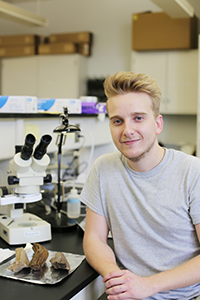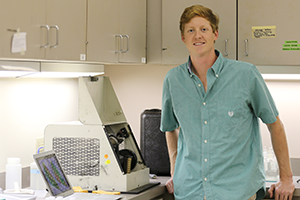Geology Student Research and Discoveries
Meet three of UL Lafayette’s geology graduate students. Their geology research projects cover environmental and petroleum geology and have the potential to improve oil and gas exploration and our understanding of climate change.
Collin Moore
Collin Moore is earning his master’s in geology and is set to graduate this December. For his geology research project, he is working with his advisor, Dr. Brian Schubert, to determine the variations in temperatures in the Siberian Arctic during the late Pleistocene era.
To determine the temperatures, his advisor collected 40,000-year-old fossil wood from northeast Siberia and Collin is analyzing the tree ring cellulose and its variations within each year. He extracts the cellulose, weighs it, and then measures the oxygen isotopes. From the isotope measurements, he can discern the climate conditions during the year the ring was formed.
“For my site in the arctic and my time period, nobody has figured out the temperature of the late Pleistocene yet, so this is totally new research,” Collin says. “We don’t have any other data for the region or the time.”
So far, Collin has determined a maximum temperature of 6 degrees Celsius. He anticipates the temperatures will be colder than today, because the carbon dioxide levels were much lower than they are today. With lower carbon dioxide levels, you get lower temperatures. For this particular time period and location, however, ocean circulation may have caused the temperature to be higher.
“The Bering Strait at the time was exposed above sea level and that may have cut off ocean circulation, which would affect temperature,” he says. “So I need to run the calculations and if it is warmer, figure out a reason why.”
Most studies of this nature focused on the year-to-year differences in temperature in the Arctic, but there are few that look at changes within a year, which is Collin’s focus.
To solve for temperature, Collin is using calculations based on data and equations published by advisor and Dr. Hope Jahren. Once the analysis is complete, he is going to compare the temperature variations from the late Pleistocene era to today, which will help gauge how atmospheric carbon dioxide concentrations may affect temperatures in the future.
Hunter Lipman
Hunter Lipman's geology research project focuses on geochemical analysis of source rock samples from the Marcellus Shale in northeastern Pennsylvania. He works as a graduate assistant in the School of Geosciences and plans to graduate December 2016.
“My research can be applied during source rock analysis, which is very critical in the search for oil and gas accumulations,” says Hunter. “My research provides a better understanding of the rock itself, decreasing the room for error during hydrocarbon exploration.”
He is working to integrate inorganic geochemical data and geophysical data from well logs to recreate the formation of deposits in the region. He will be closely studying the ancient reduction and oxidation (redox) conditions, productivity conditions, and siliciclastic influx—all conditions that have a direct impact on source rock potential.
“I chose to focus on the geochemistry of shales for my thesis because I saw how important shale research was when I interned for an oil and gas company in 2014,” says Hunter.
After taking Dr. David Borrok’s petroleum geochemistry course here at school, I knew for sure that this is what I wanted to do.”
“My favorite part about the masters program here at UL Lafayette is that you can tell that the teachers genuinely care about you learning and want you to succeed,” he says. “The education provided here has allowed friends of mine to succeed as petroleum geologists, environmental geologists, as well as government geologists.”
When looking at different geology graduate programs, Hunter chose to attend UL Lafayette because multiple industry geologists recommended the program after seeing the geology graduate students here win the AAPG Imperial Barrel Award Competition twice.
“That really caught the attention of oil companies and proves that we are among the top petroleum geology schools in the world,” he says.
Logan Adams
Logan Adams is a geology master’s student whose research focuses on enhanced recovery of crude oil at the Teapot Dome in Wyoming and well log analysis for various types of rock formations. Logan’s project is funded through Stranded Oil Resources Corporation, where he was previously an intern. Of the geology graduate programs he was considering, he chose UL Lafayette’s geology master’s program because of its oil and gas focus, and he is set to graduate in December 2016.
Stranded Oil Resources Corporation purchased the field and mineral rights to the Teapot Dome area in 2014, and now Logan’s research will help them do enhanced recovery for the rest of the oil left in that field. Typical wells are straight down, but new methods include drilling horizontally into rock formations. Logan is taking core and cutting samples from the conventional vertical wells at Teapot Dome and analyzing them to create maturation models. Logan learned these modeling techniques through his classes and through preparing for the AAPG Imperial Barrel Award Competition. The models he creates for his thesis project will help determine if it’s worthwhile to drill horizontally to extract more oil.
“My geology research project is about the thermal maturation of the rock and how much organic content is in there,” says Logan. “So to have oil generation, you have to have a certain amount of organic matter that was buried, whether that’s plankton to grass to sticks—whatever at the time. I’m going to model all of that and show how many hydrocarbons have been expelled or are still in tact in the source rocks.”
So far, his samples show there is immature oil in the field. Now, he uses thermomodeling to determine if the oil was generated in place or if it migrated there through natural fractures.
“So we’re wondering if they go in and go horizontally, will they get the same oil they’ve been getting, or are they going to get new oil by releasing more from the rock?” Logan says. “The cool thing about it is that whenever you have a very similar field with similar lithologies, similar rocks, everything, you can take the data and you can explore further into other fields.”
The other part of Logan’s thesis project is to analyze various well log analysis methods to prove which method best suits each kind of source rock for determining organic matter and maturation, so companies can evaluate the viability of extracting oil without having physical samples of the rock.
“You can go to a field when you have those formations, but you don’t have the cuttings or core because those are expensive to get, especially if it’s an old field,” says Logan. “You can just go in with the free well logs and work them over and see, using these methods that we determined are accurate, that we have maturation so we should come in and drill more wells.”
